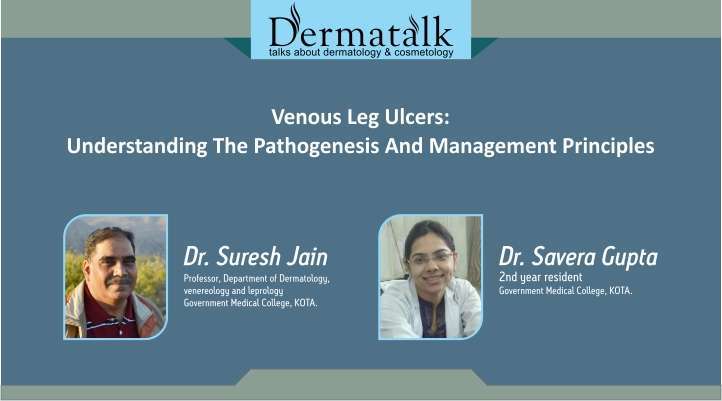Chronic leg ulcers can be defined as any ulcer on the lower leg (excluding those on the forefoot or toes) lasting for more than six weeks with no tendency of healing after three months or more.Among the various etiological factors leading to leg ulcers, venous disease is responsible for 60-70% of the cases and the gaiters area above the medial malleolus is the classical site of venous leg ulcers. Patient management is largely dependent on understanding the disease pathogenesis.
Presently, ambulatory venous hypertension, due any reason, is the most accepted cause of venous disease. The pressure dynamics of venous system and pathogenesis of venous disease have been schematically explained in figure 1 and 2 respectively.
The first step in management of patients with venous ulcers would be to identify the treatable underlying cause. This includes appropriate history and keen identification of risk factors, followed by complete examination and relevant investigation such as Doppler study or venography. The management of venous disease comprises of the following:
1. General measures: Aim is to increase the venous return and improve microcirculation
- Leg end elevation- above the level of heart during sleeping
- Graduated compression stockings- must be worn before getting down from bed and continue wearing throughout the day. The ideal compression to overcome venous hypertension would be 40mm Hg at the ankle and the below-knee stockings are preferred over above-knee as the latter are uncomfortable and tend to roll in. Also, the circumference of stocking must be adjusted as per the circumference of ankle as according to the Laplace’s law, larger diameter of ankle would require more pressure from the stockings in order to counteract the internal venous pressure.
- Weight reduction
- Improved nutrition and mobility
2. Ulcer management– Aim is to promote healing and prevent recurrence.This is a challenging task as these patients have high chances of contact sensitivity, especially to wool alcohols, topical antibiotics, cetylstearyl alcohols, parabens, and rubber mixes, which are present in many dressings, ointments, and creams.
- Cleaning the ulcer with sterile saline would generally suffice.
- Non adherent dressings- For mild to moderately oozing ulcers, hydrogel dressings could be used. Alginate dressings are preferred for heavily oozing lesions where they help by exudate absorption as well as promoting the fibroblast proliferation.
- Topical antibiotics- not routinely recommended. Use if there is evidence of infection.
- Analgesia- amitriptyline, gabapentin
- Quinine- particularly useful for night cramps
- Other drugs with variable success- pentoxyfylline, rutoside, stanozolol, sulodexide, aspirin
- Investigational therapies-cytokines that promote healing such as platelet derived growth factor, hepatocyte growth factor, and human keratinocyte growth factor-2
- Skin grafting- for non-healing ulcers.As split skin grafts carry the risk of dislodgement due to exudates, mesh or pinch grafts are preferred.
- Bioengineered skin products, including bilayered skin constructs and frozen human allogeneic epidermal cultures, are being developed and may stimulate wound healing through the release of growth factors and cytokines.
3. Correcting the underlying pathology-
- Incompetent superficial/perforator vein – sclerotherapy/ surgical removal. The prerequisite for performing any surgery on the superficial varicose veins is the patency of the deep venous system. However, in cases of deep vein insufficiency surgery must be strictly avoided as superficial veins act as major route of venous return in these cases.
- Deep vein insufficiency- Adequate treatment of deep vein thrombosis so as to prevent damage to valves and post DVT syndrome. Pelvic mass/tumor causing extravascular compression can be surgically removed.
As prevention is better than cure, the target must be to identify the patients with venous hypertension at the earliest stage and prompt institution of therapy in the form of lifestyle modification, compression stockings ad limb elevation. This would definitely bring down the incidence of active ulcers in the at-risk population and hence improve the quality of life of patients.








